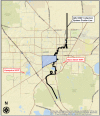Assessment of a mass balance equation for estimating community-level prevalence of COVID-19 using wastewater-based epidemiology in a mid-sized city
- PMID: 36352013
- PMCID: PMC9645338
- DOI: 10.1038/s41598-022-21354-6
Assessment of a mass balance equation for estimating community-level prevalence of COVID-19 using wastewater-based epidemiology in a mid-sized city
Abstract
Wastewater-based epidemiology (WBE) has emerged as a valuable epidemiologic tool to detect the presence of pathogens and track disease trends within a community. WBE overcomes some limitations of traditional clinical disease surveillance as it uses pooled samples from the entire community, irrespective of health-seeking behaviors and symptomatic status of infected individuals. WBE has the potential to estimate the number of infections within a community by using a mass balance equation, however, it has yet to be assessed for accuracy. We hypothesized that the mass balance equation-based approach using measured SARS-CoV-2 wastewater concentrations can generate accurate prevalence estimates of COVID-19 within a community. This study encompassed wastewater sampling over a 53-week period during the COVID-19 pandemic in Gainesville, Florida, to assess the ability of the mass balance equation to generate accurate COVID-19 prevalence estimates. The SARS-CoV-2 wastewater concentration showed a significant linear association (Parameter estimate = 39.43, P value < 0.0001) with clinically reported COVID-19 cases. Overall, the mass balance equation produced accurate COVID-19 prevalence estimates with a median absolute error of 1.28%, as compared to the clinical reference group. Therefore, the mass balance equation applied to WBE is an effective tool for generating accurate community-level prevalence estimates of COVID-19 to improve community surveillance.
© 2022. The Author(s).
Conflict of interest statement
The authors declare no competing interests.
Figures




References
-
- Centers for Disease Control Prevention. Public Health Surveillance: Preparing for the Future, vol. 21, 2020 (US Department of Health and Human Services, 2018).
-
- Thacker SB, Qualters JR, Lee LM. Public health surveillance in the United States: Evolution and challenges. MMWR Suppl. 2012;61(3):3–9. - PubMed
-
- Centers for Disease Control and Prevention. United States COVID-19 Cases and Deaths by State. 2021 March 29 (2021); Available from: https://covid.cdc.gov/covid-data-tracker/#cases_casesper100klast7days.
-
- World Health Organization . Public Health Surveillance for COVID-19: Interim Guidance. Geneva: World Health Organization; 2020.
Publication types
MeSH terms
Substances
Grants and funding
LinkOut - more resources
Full Text Sources
Medical
Miscellaneous

